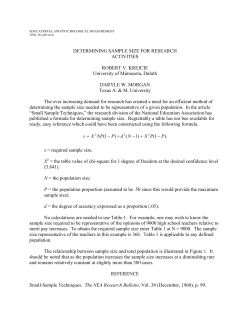
9.2 - DanShuster.com!
Quiz 9.2A 1. (a) State: We wish to test H 0 : p = 0.11 versus H a : p < 0.11 , where p = the true proportion of nonconforming items. We will use a significance level of α = 0.05. Plan: The procedure is a one-sample z-test for a proportion. Conditions: Random: A random sample of items was taken. 10%: We must assume that the trial run consisted of at least (10 )(300 ) = 3000 items. Large counts: Assuming H 0 : p = 0.11 is true, np = (300) ⋅ ( 0.11) = 33 ≥ 10, and n (1 − p ) = (300 ) ⋅ (0.89 ) = 267 ≥ 10. 0.0533 − 0.11 16 Do: pˆ = = −3.14 ; P-value = 0.0008. Conclude: A P-value of = 0.0533 , so z = 300 ( 0.11)( 0.89 ) 300 0.0008 is less than α = 0.05, so we reject H0 and conclude that there is convincing evidence that the true proportion of nonconforming items is less than 0.11. (b) If H 0 : p = 0.11 is true, there is a probability of 0.0008 of getting a sample proportion of nonconforming items as far or farther below 0.11 as 0.05333 is. 2. (a) Power = 0.69 measures the probability of correctly rejecting the null hypothesis and concluding that the true proportion of seeds that germinate is different from 0.8 when it is actually 0.75. (b) Increase power by increasing the sample size or increasing the significance level. (c) Since the 95% confidence interval contains the null value of 0.8, we cannot reject H0 at the α = 0.05 level. We do not have convincing evidence that the germination rate of the seeds was changed by the chemical spray. Quiz 9.2B 1. (a) State: We wish to test H 0 : p = 0.12 versus H a : p > 0.12 , where p = the true proportion of red cars in the parking lot. We will use a significance level of α = 0.05. Plan: The procedure is a one-sample z-test for a proportion. Conditions: Random: The fan took an SRS of 210 cars. 10%: 210 is clearly less than 10% of all the cars in the lot. Large counts: Assuming H 0 : p = 0.12 is true, np = ( 210) ⋅ (0.12 ) = 25.2 ≥ 10, and n (1 − p ) = ( 210 ) ⋅ (0.88) = 184.8 ≥ 10. Do: pˆ = z= 0.1667 − 0.12 ( 0.12 )( 0.88) 35 = 0.1667 , so 210 = 2.081 ; P-value = 0.0187. Conclude: A P-value of 0.0187 is less than α = 0.05, so 210 we reject H0 and conclude that there is convincing evidence that the true proportion of red cars at Citizens Bank Park is greater than 0.12. (b) If H 0 : p = 0.12 is true, there is a probability of 0.0187 of getting a sample proportion of red cars as far or farther above 0.12 as 0.1667 is. 2. (a) Power = 0.36 measures the probability of correctly rejecting the null hypothesis and concluding that the true proportion of voters that support the candidate is different from 0.44 when it is actually 0.40. (b) Increase power by increasing the sample size or increasing the significance level. (c) Since the 95% confidence interval contains the null value of 0.44, we cannot reject H0 at the α = 0.05 level. We do not have convincing evidence that the attack ads change the level of support for the candidate. ©BFW Publishers The Practice of Statistics for AP*, 5/e Quiz 9.2C 1. State: We wish to test H 0 : p = 0.4 versus H a : p > 0.4 , where p = Leroy’s new free throw accuracy, expressed as the true proportion of all shots he will take this season that he’ll make. We will use a significance level of α = 0.01. Plan: The procedure is a one-sample z-test for a proportion. Conditions: Random: We will have to assume that LeRoy’s first 40 attempts this season are an SRS of all shots he might over the remainder of his career (and that he will take more than 400 shots) . Large counts: Assuming H 0 : p = 0.4 is true, np = ( 40) ⋅ (0.4 ) = 16 ≥ 10, and n (1 − p ) = ( 40) ⋅ (0.6) = 24 ≥ 10. Do: 0.625 − 0.4 25 = 2.90 ; P-value = 0.0018. Conclude: A P-value of 0.0018 is less = 0.625 , so z = 40 ( 0.4 )( 0.6 ) 40 than α = 0.01, so we reject H0 and conclude that there is convincing evidence that LeRoy’s free-throw shooting percentage has improved. 2. (a) Since the 99% confidence interval does not contain the null value of 0.5, we can reject H0 at the α = 0.01 level. We have convincing evidence that the proportion of males births is different from the proportion of female births. (b) The confidence interval gives a range of plausible values for the proportion of male births; the test of significance does not. (c) This means that there is only a 0.06 probability that we will reject the (false) null hypothesis that p = 0.5. Power can be increased by increasing the sample size or by increasing the level of significance (which was 0.01 for this test, since we used a 99% confidence interval). pˆ = ©BFW Publishers The Practice of Statistics for AP*, 5/e
© Copyright 2025











